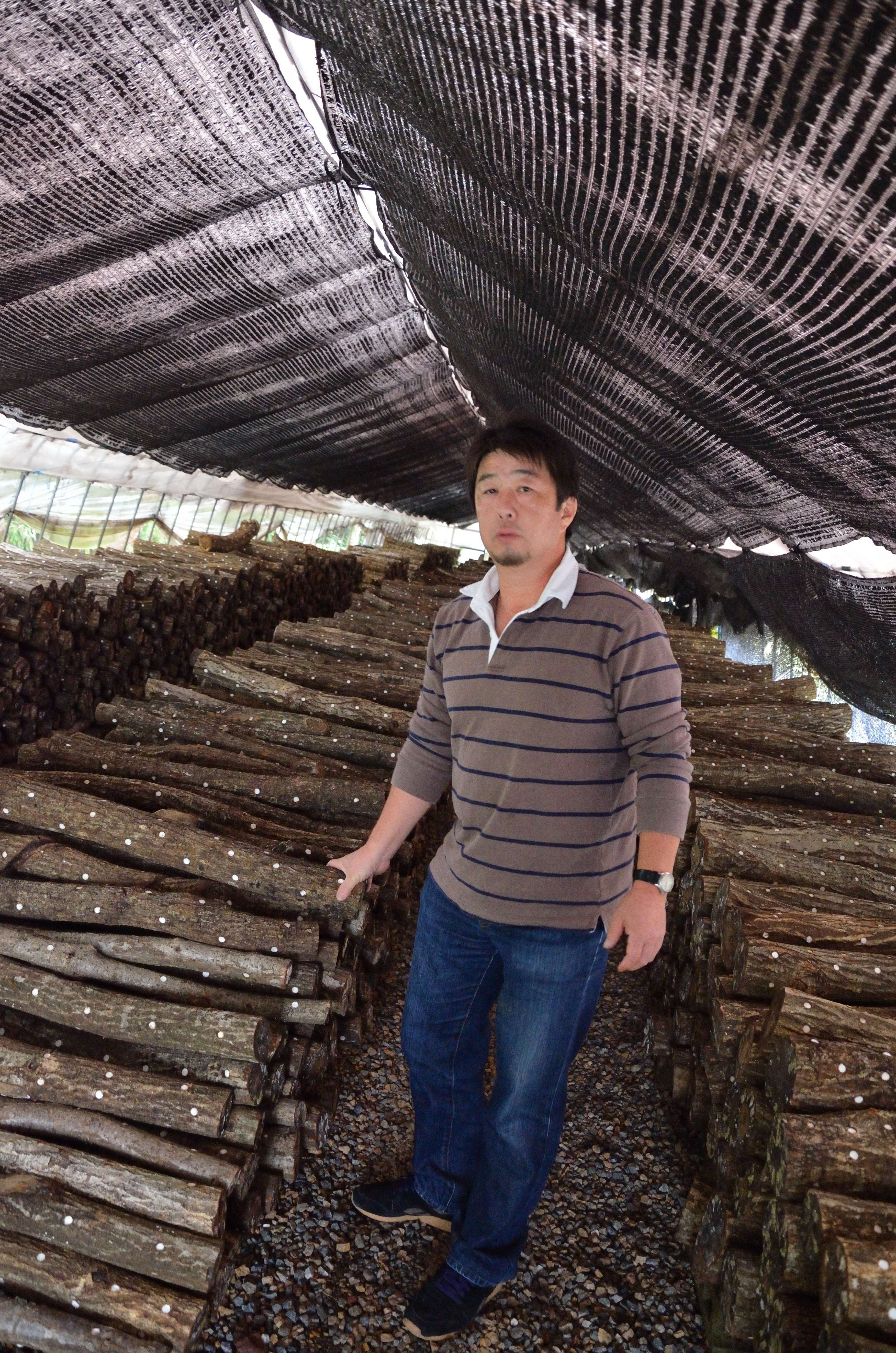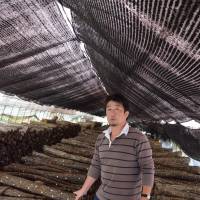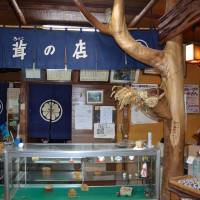For Yuji Hoshino, mushrooms were a way of life. The 50-year-old farmer grew up watching his father raise shiitake mushrooms on their land at the foot of the mountains in Sano, southern Tochigi Prefecture.
Later, he became the one to yearly cut about 15,000 logs, each about a meter long and the diameter of a coffee saucer, from oak forests near his home. He would stud these logs with specially inoculated spore pegs and then stack them in forests and greenhouses for the crop to mature. Three to eight years later, hundreds of thousands of fleshy, white-and-brown mushrooms would be ready to pick.
The business had always been a family affair. His wife, Fumiko, was in charge of harvesting, his mother sold the organic fresh and dried mushrooms at a small specialty shop in central Sano, and his father lent a hand all around. Hoshino's four children, three cats and four dogs used to hold down the rambling old farmhouse. When Hoshino drove into town, it was at the wheel of a gray van proudly emblazoned with the farm slogan: "Hoshino Mushroom Shop: The lively scent of the mountains."
But the ongoing disaster that began at the Fukushima No. 1 nuclear power plant following the Great East Japan Earthquake on March 1, 2011 has shattered Hoshino's mushroom-centered world.
Because of fallout from three reactor meltdowns there, he has not sold a single shiitake since last May, and now has to support his family with compensation payments from the plant's operator, Tokyo Electric Power Co. (Tepco).
"Log-grown mushrooms were a symbol of safe, chemical-free food. That's been turned upside down," said the stocky, self-assured farmer. "I can't sell my products with pride anymore."
Meanwhile, the future of the wild plants, animals, and insects in the coppiced oak woodlands where he used to cut logs for the shiitake crop are also threatened.
The same is true throughout northeastern Japan. Because mushrooms are more prone than other crops to absorb the radioactive cesium spread by the disaster, growers continue to suffer even in areas where other farmers have returned to business-as-usual. And because mushroom production is closely entwined with a certain type of forested habitat, troubles in the industry presage ecological as well as human impacts.
Hoshino's farm is about 180 km from the destroyed reactors. However, radiation levels are lower there than they are in some parts of Tokyo; even in Hoshino's own forests, they are now at near-background levels. But as he began testing dried shiitakes in the fall of 2011, he discovered some that exceeded the legal limit for contamination, which at the time was 500 becquerels per kg (Bq/kg).
In response, he stopped selling mushrooms harvested since the disaster; soon after, the government placed a prohibition on the sale of dried mushrooms from the town.
Although fresh shiitakes from Sano could still be sold, Hoshino chose not to do so because he could not guarantee they were safe. Consequently, he shut down the family store last May and began disposing of 30,000 logs exposed to radioactive rain.
As the new reality had sunk in over the winter of 2011-12, Hoshino said that anger toward Tepco and the Japanese government overwhelmed him: His blood pressure skyrocketed and he could constantly feel his heart beating.
"Everything I've done up till now, it's all become no good. I can't collect wild vegetables and I can't sell my mushrooms. There are problems with the fish in the rivers and I have to worry about contamination levels in the wild game, too. That's what makes me the most angry," he said.
By the spring of 2012, he had thrown himself into preparing paperwork to submit to Tepco to receive compensation for the family's lost income. Unable to fit his business model into the forms the utility sent him, he spent months documenting his losses with thick binders of photographs, text and tables. So far, he has received three payments.
"This is really hard stuff for an individual farmer to do. But I have an eight-person family with three kids in university. I couldn't wait. I've got past the anger," he said.
The future of the family business remains unclear. In forests and villages near the Chernobyl nuclear power plant in present-day Ukraine, where explosions and fires almost 27 years ago caused a widespread release of radioactive fallout, "hot" mushrooms remain a symbol of persistent environmental contamination.
Satoshi Yoshida, a researcher at the National Institute of Radiological Sciences, says scientists still don't know exactly why or how mushrooms accumulate so much cesium. But one reason, he says, is that large amounts of the contaminant remain available to them in forest environments for many years.
Japanese shiitakes are grown on logs, or — more commonly these days — on blocks made of sawdust, corncobs or other farm by-products. Those grown on logs are particularly vulnerable to contamination: According to Forestry Agency tests, shiitakes can accumulate double the concentration of radiocesium of the wood they are grown on. (Rice, in contrast, usually has one-tenth or less the radiocesium concentration of the paddy soil it is grown in.)
Additionally, mushrooms can absorb contaminants from the air or rain if they're raised outdoors, as are most shiitakes grown for drying.
With new food-safety laws limiting contamination to 100 Bq/kg of mushrooms, logs are permitted to have just 50 Bq/kg — and that's led to a shortage of nearly 2 million logs, the Forestry Agency says. Meanwhile, contaminated mushrooms keep turning up even as sales of farmed or wild mushrooms, or both, are still banned in dozens of cities in 13 prefectures.
One result of the restrictions is that northeastern farmers are abandoning coppiced oak stands. These scrubby, open forests were customarily cut on a 10- to 20-year cycle to supply logs for growing shiitake mushrooms or making charcoal, then allowed to regenerate as new trunks sprouted from the bases of harvested trees.
"Coppicing is important to renew and change the forest structure," explained Tatsuhiro Ohkubo, a forest ecologist at Utsunomiya University in central Tochigi Prefecture. "When people clear-cut small patches, it causes a drastic change that opens up the area to grassland, with flora and fauna that prefer that habitat. The mosaic structure of the coppiced stands is very effective for maintaining biodiversity."
Traditionally, rural families maintained these stands by harvesting grasses and leaves to enrich their farm fields, firewood to warm their homes and plants to make food, medicine and household items. But by the mid-20th century, woodlands had lost most of their practical purpose.
As a result, some were cleared to make way for housing developments or single-species timber plantations. In other places, trees grew larger and underbrush thickened, creating stands similar to climax forests deeper in the mountains. Many of the species traditionally found in the coppice — from insectivorous Indian sundews to graceful dogtooth violets and Tokyo salamanders — joined the ranks of locally or nationally threatened species.
The shiitake mushroom industry has been a saving grace for some of these species. Booming just as other farmstead uses for mixed woodlands declined, it gave farmers a reason to continue managing a patch or two of coppice. That was especially true in Fukushima Prefecture, which before the disaster supplied about half of all the logs sold nationwide for growing shiitake.
Recently, however, demand for logs has fallen as more and more farmers switch to factory-made blocks. In addition, a virulent bacterial disease called Japanese oak wilt, that's spread by beetles, has also been creeping northward through Honshu, devastating many of the coppiced oak stands that remain.
"That was a threat before 3/11. Now we are facing a double threat," said Ohkubo, referring to the likelihood that many mushroom farmers will stop using logs from northeastern Japan, and many more forests will be abandoned due to the nuclear disaster.
For Hoshino, that appears to be the only option. Last year he harvested 7,000 logs from his property. Those that he sampled had low enough contamination levels to warrant a test crop — but even so, he scrubbed each one with a wire brush before planting. This year, he decided to use logs from southern Japan. "I want to be able to tell my customers they are getting something absolutely safe," he said.
The strategy may just save Hoshino's business, but not northeastern Japan's stands of coppiced oaks.
"The number of people growing shiitakes on logs was already falling drastically. Because of the nuclear accident, the cycle of going into the forest and using the trees is simply disappearing more quickly," he said.
With it, a way of life and a unique rural environment may disappear as well.





















With your current subscription plan you can comment on stories. However, before writing your first comment, please create a display name in the Profile section of your subscriber account page.